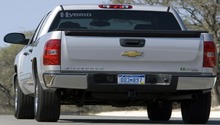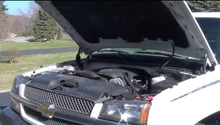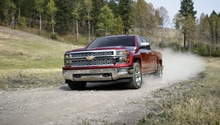Chevrolet Silverado 2007-2013: Common Problems
Knowing a vehicle's potential problem areas (and possible solutions) can save you from unexpected repair bills down the road.
This article applies to the Chevrolet Silverado 1500 (2007-2013).
As vehicles age, problems will crop up sooner rather than later. There are often common problems to watch out for as the mileage adds up. While the Silverado is generally reliable (many owners report driving their trucks well over 100,000 miles with few problems), there are some issues to watch out for. Some problems are specific to the exact model, while others are more general. Here's an overview of common problems you might experience with your Silverado.
Common Problems
Steering Shaft
The symptom is described as an unsettling noise and feeling in the suspension. Many owners report having the steering shaft replaced only to have the problem return a short while later. One possible solution is to spray the yoke connection (where the steering wheel attaches to the shaft) with silicone spray.

Ticking Noise and/or Misfiring
Customers often report seeing a check engine light along with misfires, especially at higher speeds and a rough idle. The problem could be the result of an AFM (active fuel management, V8 to V4 models) lifter that unlocks once the engine is started. The part could also be collapsed or stuck on all the time. A ticking noise is often heard if the AFM unlocks as soon as the engine is started, but not if it's mechanically collapsed or stuck.

Bad Battery/Battery Connections
A failing or bad battery, as well as loose connections can wreak havoc with the truck's electrical system. Possible symptoms include power locks locking and unlocking on their own, dashboard lights flickering, as well as the radio turning on and off. Some trucks may have a hard start, or will refuse to start again after being parked and shut off. If the battery isn't the culprit, check the grounds, cables, and wires around the battery for signs of corrosion or excessive wear and tear.

Dirty Seats
Several owners with cloth seats note that they tend to collect dust and lint very quickly. The solution is quite simple, and involves using a lint brush (or a vacuum) to clean the seats. Another solution is to buy seat covers or guards. A handful of owners complain that the cloth upholstery also stains easily, and note that the only way to really get rid of the stains is to have the interior detailed, which is an expensive option for larger cars and trucks. Owners with leather upholstery don't report any problems with their seats getting dirty faster than normal.

Related Discussions
- Common Problem, Cheap Fix - ChevroletForum.com
- 2010 5.3L Silverado Problems - ChevroletForum.com
- 2008 Silverado 1500 Big Problems - ChevroletForum.com
- 2007 Chevy Silverado...Any Problems? - ChevroletForum.com






